Oven-Roasted Turkey Recipe
Introduction to the Recipe
There’s nothing more classic or comforting than a perfectly Oven-Roasted Turkey — golden, crisp-skinned, and juicy throughout. Whether it’s Thanksgiving, Christmas, or a special family gathering, this recipe ensures your turkey turns out flavorful, moist, and beautifully roasted every single time.
This oven-roasted turkey recipe balances a seasoned dry rub with aromatic herbs, citrus, and garlic for maximum flavor. The secret to success lies in a simple dry brine that locks in moisture and guarantees crispy skin, while the aromatic stuffing — fresh sage, thyme, shallots, garlic, and lemon — infuses every bite with deep, savory notes.
Unlike overly complicated versions, this recipe keeps things approachable without compromising on flavor. The mix of kosher salt, baking powder, and brown sugar helps tenderize the meat and enhance browning, while the smoked paprika adds subtle depth. Roasted slowly until golden perfection, this turkey makes a show-stopping centerpiece that’s both juicy and rich in flavor.
If you love hearty, comforting main courses, you’ll also enjoy Slow Cooker Beef Stew or Crockpot Chicken Enchilada Casserole. Both pair beautifully with this turkey as part of a festive meal plan.
With this detailed guide, you’ll learn not just how to cook your oven-roasted turkey perfectly, but also how to season, rest, and carve it like a pro.
Basic Recipe: Ingredients and Instructions
Print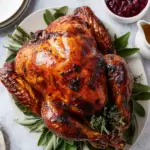
Thanksgiving Oven-Roasted Turkey Recipe
Description
Perfect Oven-Roasted Turkey with crispy skin, juicy meat, and aromatic herbs — a simple yet impressive holiday classic.
Ingredients
For the turkey:
- 1 (12-lb.) frozen turkey, thawed, neck and giblets removed
- 1/4 cup kosher salt
- 2 Tbsp. freshly ground black pepper
- 1 Tbsp. baking powder
- 1 Tbsp. dark brown sugar
- 1 Tbsp. garlic powder
- 2 tsp. dried thyme
- 2 tsp. onion powder
- 2 tsp. smoked paprika
- 1 shallot or small yellow onion, quartered
- 1 head of garlic, halved through the equator
- 1 lemon, quartered
- 1 small bunch fresh sage
- 1 small bunch fresh thyme
- 1/4 cup neutral oil (like canola or grapeseed)
Instructions
- Prepare the turkey
Remove the thawed turkey from packaging and pat dry thoroughly with paper towels. Make sure to remove the giblets and neck from the cavity. - Make the dry rub
In a small bowl, combine kosher salt, black pepper, baking powder, brown sugar, garlic powder, dried thyme, onion powder, and smoked paprika. Mix well. - Apply the dry brine
Rub the mixture all over the turkey, including under the skin where possible. Place the turkey uncovered on a rack set over a tray and refrigerate for 12–24 hours. This step helps draw out moisture and ensures crispy skin. - Preheat the oven
Set the oven to 325°F (165°C) and let the turkey come to room temperature for about 45 minutes before roasting. - Stuff the cavity
Fill the turkey cavity with the quartered shallot, halved garlic, lemon wedges, and fresh herbs (sage and thyme). - Brush with oil
Rub the turkey generously with neutral oil, coating it evenly. This helps the skin turn golden and crisp. - Roast the turkey
Place the turkey breast side up on a roasting rack inside a large roasting pan. Roast for about 13–15 minutes per pound, or until the internal temperature reaches 165°F (74°C) in the thickest part of the breast. - Rest before carving
Remove from the oven, tent loosely with foil, and let rest for 30–45 minutes before carving. This allows juices to redistribute and keeps the meat tender.
Notes
Always use a meat thermometer to ensure proper cooking without drying out the meat.
For extra-crispy skin, let the turkey air-dry in the fridge overnight after applying the rub.
You can baste halfway through roasting for deeper color, but avoid over-basting (it can soften the skin).
Save the pan drippings for gravy — they’re packed with rich, roasted flavor.
Keywords: Oven-Roasted Turkey Recipe
Advanced Techniques
1. Dry Brining for Maximum Flavor
Dry brining is the professional chef’s secret to juicy, flavorful turkey. Unlike wet brining, it doesn’t require buckets of liquid — just salt and spices. As the turkey rests with the dry rub, salt penetrates the meat, breaking down muscle proteins and locking in moisture. Baking powder helps crisp the skin by raising its pH, creating that irresistible golden crunch. The result? A turkey that’s tender inside and crisp outside.
2. Layering Aromatics for Depth
Filling the cavity with aromatics like garlic, lemon, shallots, and herbs infuses the meat with subtle fragrance. The steam from these ingredients gently perfumes the turkey as it roasts, resulting in richer flavor. For a bolder twist, add sliced apples or oranges to the cavity — they add natural sweetness and moisture.
3. Rotating the Turkey Midway
For even browning, rotate the roasting pan halfway through cooking. This ensures consistent heat distribution, especially if your oven has hot spots. For very large birds, you can start breast-side down for the first hour, then flip it — this prevents the breast meat from drying out.
4. Using Compound Butter for Extra Moisture
For the juiciest turkey, create a compound butter with herbs, garlic, and lemon zest. Carefully loosen the skin around the breast and thighs, then spread the butter underneath. This keeps the meat moist and infuses incredible flavor as it melts during roasting.
5. Letting It Rest Properly
Resting is essential. If you carve too early, the juices will escape, leaving dry meat. Tenting with foil for 30–45 minutes allows the juices to redistribute. You can prepare sides during this time, so the turkey is perfectly ready to serve.
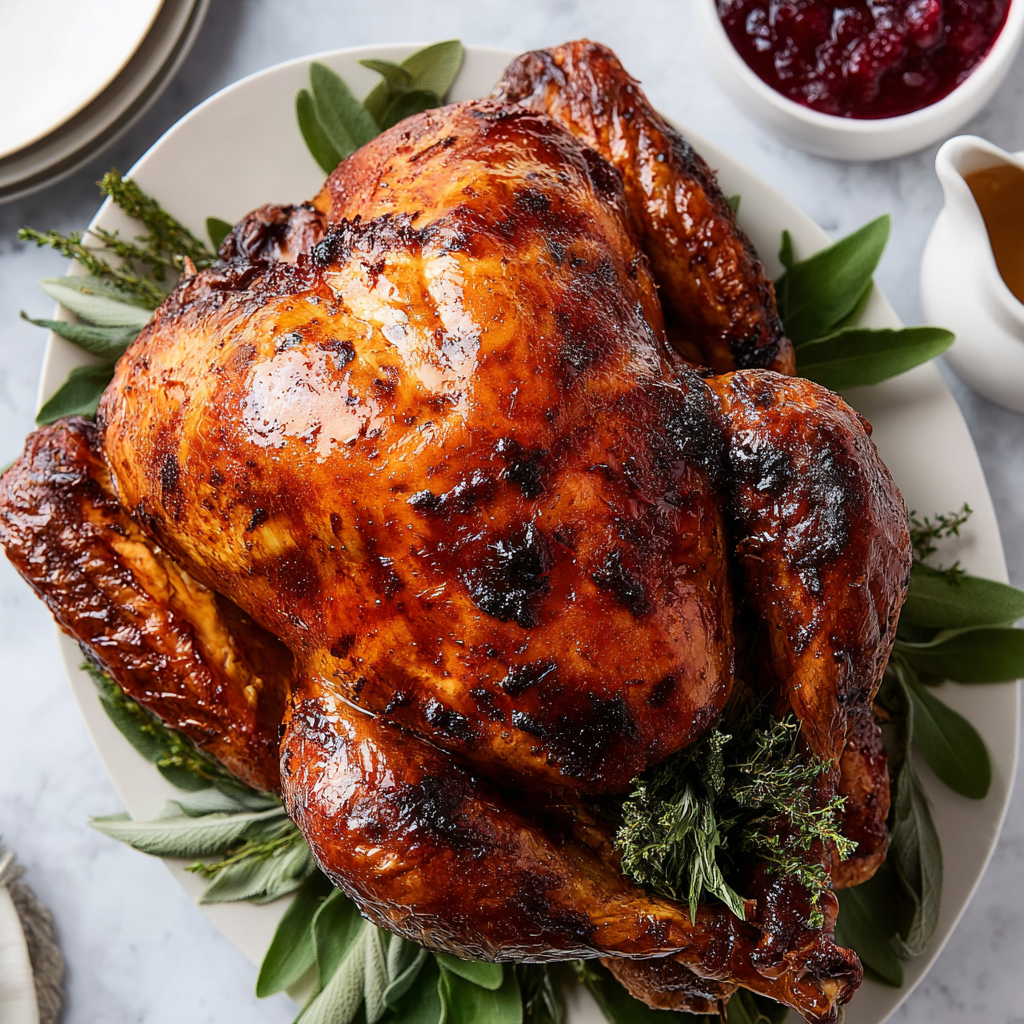
Storage, Shelf Life, and Maintenance Tips
1. Storing Leftovers
Store leftover turkey in airtight containers in the refrigerator for up to 4 days. Slice the meat before refrigerating for easier reheating and serving later.
2. Freezing Turkey Meat
For longer storage, freeze cooked turkey within 2 days. Wrap portions tightly in plastic wrap and foil, or use freezer-safe bags. It’ll keep for up to 3 months. Thaw overnight in the fridge before reheating.
3. Reheating Without Drying Out
To reheat, place slices in a covered baking dish with a splash of broth or gravy. Warm in a 300°F (150°C) oven until heated through — about 15–20 minutes. This gentle method keeps it moist.
4. Making the Most of the Carcass
Don’t toss the bones! Simmer them with onions, carrots, celery, and herbs to make homemade turkey stock. Freeze it in portions to use for soups and sauces later.
5. Avoiding Refrigerator Dry-Out
To keep leftovers moist, brush slices lightly with olive oil or butter before storing. This seals in flavor and prevents that dry, chalky texture after refrigeration.
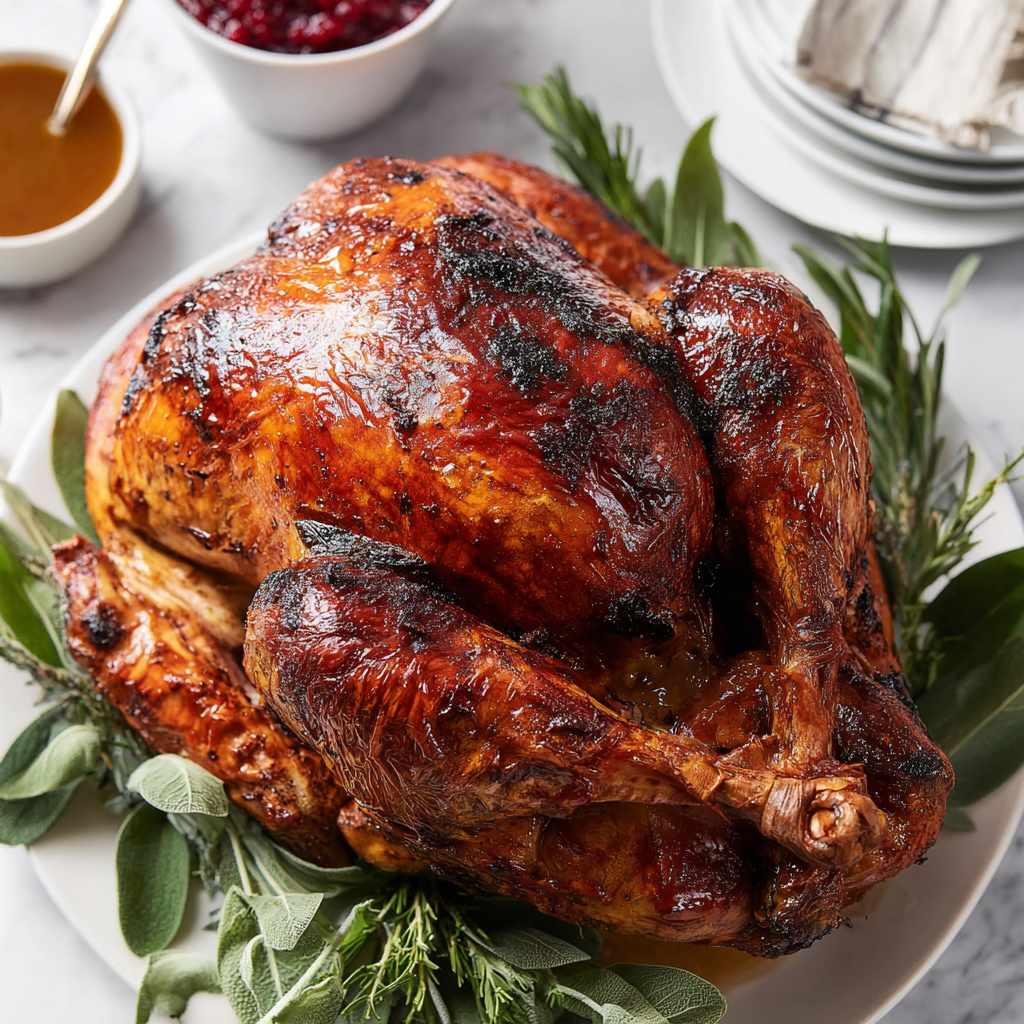
Dietary Adaptations and Substitutions
1. Low-Sodium Option
Reduce the kosher salt by half and skip the brown sugar if preferred. You can enhance flavor with extra herbs and spices instead.
2. Gluten-Free Friendly
This recipe is naturally gluten-free — just ensure your spices and baking powder are certified gluten-free to avoid cross-contamination.
3. Dairy-Free Option
No butter or dairy is used in this version, but if you prefer to baste with butter, use a plant-based version for a dairy-free alternative.
4. Keto or Low-Carb Adaptation
The recipe already fits a low-carb or keto diet. Just skip the brown sugar entirely and baste with olive oil or avocado oil instead of neutral oil.
5. Herbal Variations
Experiment with flavor profiles by swapping sage and thyme for rosemary and oregano. You can also add crushed fennel seeds for a Mediterranean twist.
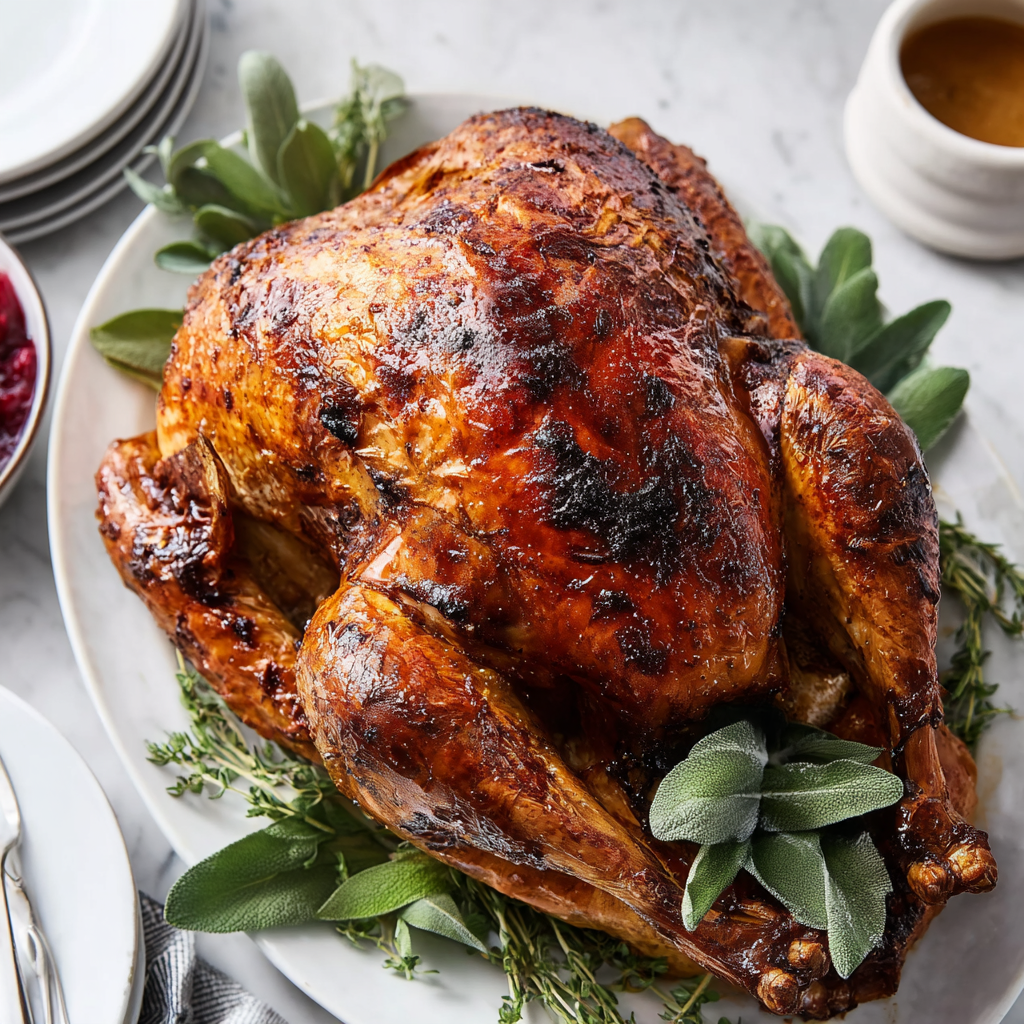
FAQs About the Recipe
1. How do I know when my turkey is done?
The safest and most accurate way is to use a meat thermometer. Insert it into the thickest part of the breast — it should read 165°F (74°C). The thighs should reach about 175°F (80°C).
2. Can I cook the turkey without brining?
Yes, but the dry brine gives a noticeable improvement in flavor and texture. If you skip it, season the turkey generously right before roasting.
3. Should I baste my turkey while it cooks?
Basting helps color the skin but isn’t strictly necessary. Too much basting can actually prevent crispiness. Once or twice during roasting is enough.
4. How can I make the skin extra crispy?
Leave the turkey uncovered in the fridge overnight after brining. The air-drying step removes surface moisture, ensuring beautifully crisp, golden skin.
5. What’s the best way to carve the turkey?
Use a sharp carving knife and start by removing the legs and wings. Slice along the breastbone, then cut crosswise for perfect slices. Always carve against the grain for tenderness.
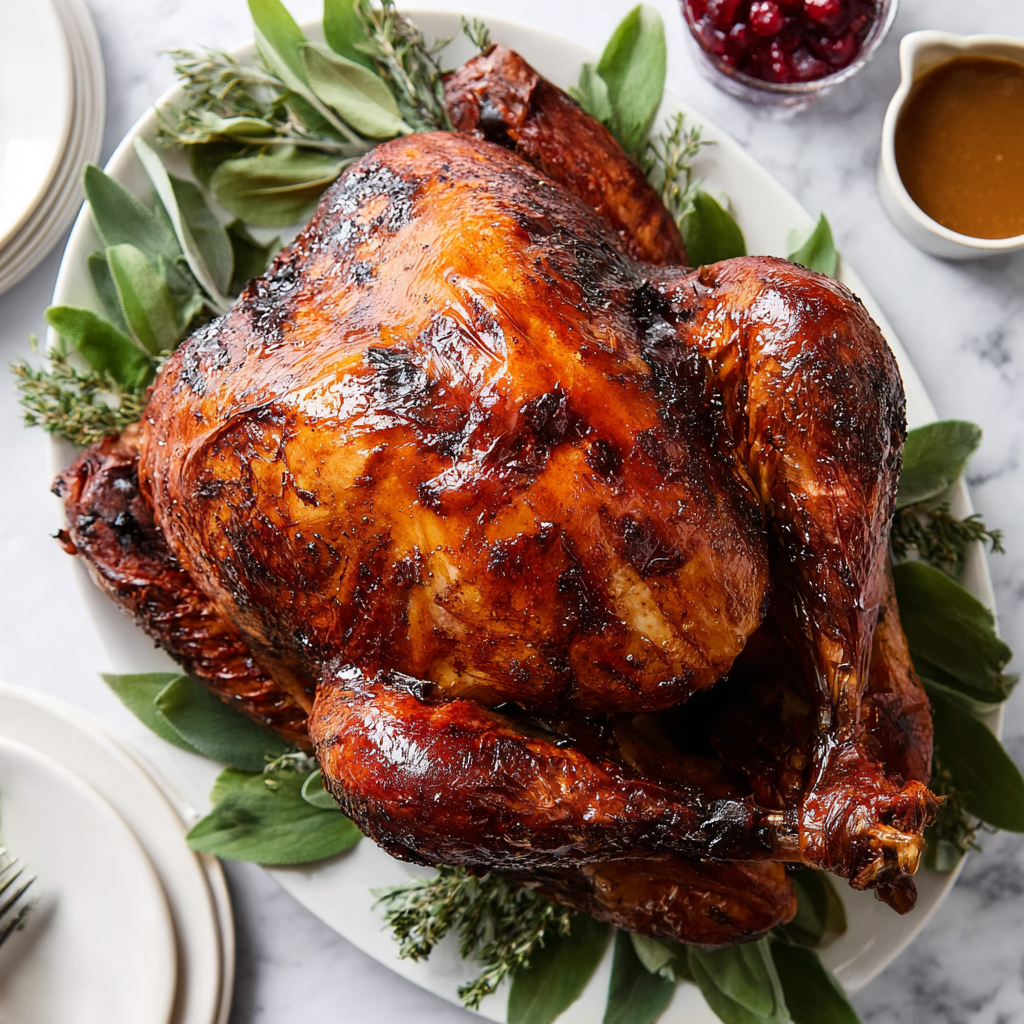
Conclusion & Final Thoughts
Oven-Roasted Turkey is the ultimate showpiece of any festive table — beautifully golden, aromatic, and bursting with flavor. With this method, you get the best of both worlds: crispy, well-seasoned skin and juicy, tender meat from breast to thigh.
The combination of salt, herbs, lemon, and garlic transforms a simple bird into a restaurant-worthy roast. By taking the time to brine, stuff with aromatics, and rest the meat properly, you ensure each slice is moist and flavorful.
This oven-roasted turkey recipe is reliable, elegant, and adaptable — perfect for both first-time cooks and seasoned hosts. Pair it with creamy mashed potatoes, roasted vegetables, or homemade gravy for a memorable meal that brings everyone to the table.
Once you’ve mastered this method, it will become your go-to centerpiece for holidays and special gatherings — a dish that not only feeds the body but also fills the home with warmth, aroma, and togetherness.
